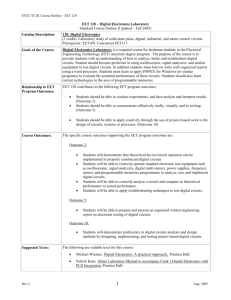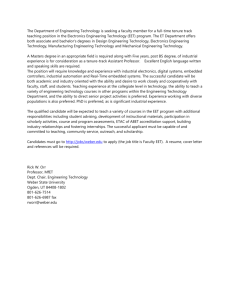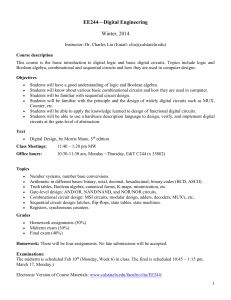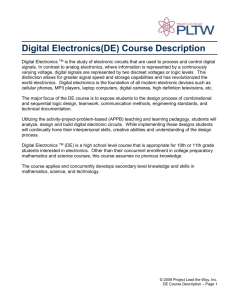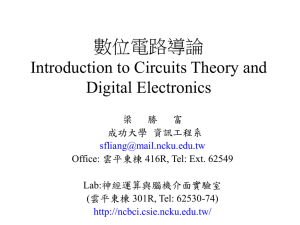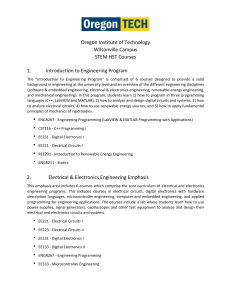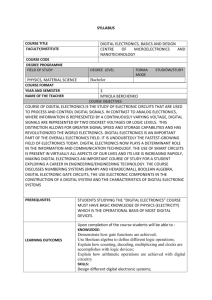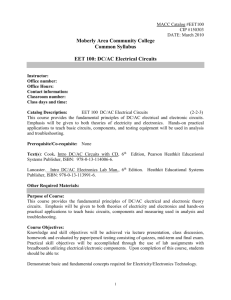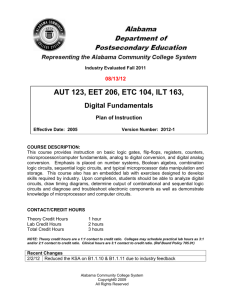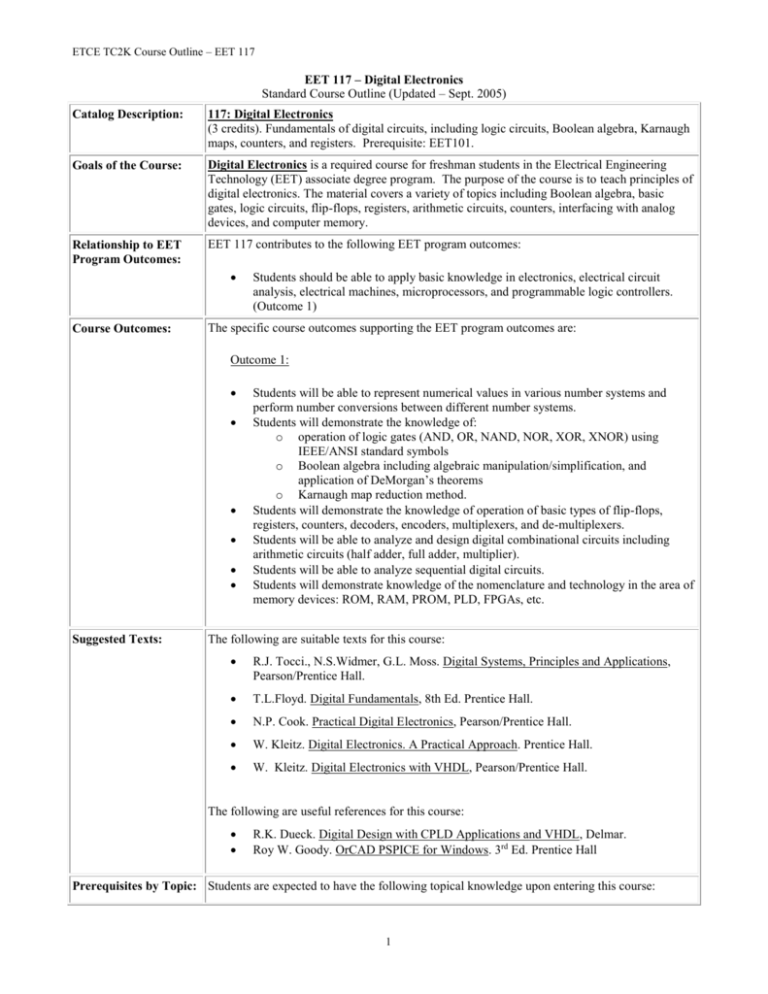
ETCE TC2K Course Outline – EET 117
EET 117 – Digital Electronics
Standard Course Outline (Updated – Sept. 2005)
Catalog Description:
117: Digital Electronics
(3 credits). Fundamentals of digital circuits, including logic circuits, Boolean algebra, Karnaugh
maps, counters, and registers. Prerequisite: EET101.
Goals of the Course:
Digital Electronics is a required course for freshman students in the Electrical Engineering
Technology (EET) associate degree program. The purpose of the course is to teach principles of
digital electronics. The material covers a variety of topics including Boolean algebra, basic
gates, logic circuits, flip-flops, registers, arithmetic circuits, counters, interfacing with analog
devices, and computer memory.
Relationship to EET
Program Outcomes:
EET 117 contributes to the following EET program outcomes:
Course Outcomes:
Students should be able to apply basic knowledge in electronics, electrical circuit
analysis, electrical machines, microprocessors, and programmable logic controllers.
(Outcome 1)
The specific course outcomes supporting the EET program outcomes are:
Outcome 1:
Suggested Texts:
Students will be able to represent numerical values in various number systems and
perform number conversions between different number systems.
Students will demonstrate the knowledge of:
o operation of logic gates (AND, OR, NAND, NOR, XOR, XNOR) using
IEEE/ANSI standard symbols
o Boolean algebra including algebraic manipulation/simplification, and
application of DeMorgan’s theorems
o Karnaugh map reduction method.
Students will demonstrate the knowledge of operation of basic types of flip-flops,
registers, counters, decoders, encoders, multiplexers, and de-multiplexers.
Students will be able to analyze and design digital combinational circuits including
arithmetic circuits (half adder, full adder, multiplier).
Students will be able to analyze sequential digital circuits.
Students will demonstrate knowledge of the nomenclature and technology in the area of
memory devices: ROM, RAM, PROM, PLD, FPGAs, etc.
The following are suitable texts for this course:
R.J. Tocci., N.S.Widmer, G.L. Moss. Digital Systems, Principles and Applications,
Pearson/Prentice Hall.
T.L.Floyd. Digital Fundamentals, 8th Ed. Prentice Hall.
N.P. Cook. Practical Digital Electronics, Pearson/Prentice Hall.
W. Kleitz. Digital Electronics. A Practical Approach. Prentice Hall.
W. Kleitz. Digital Electronics with VHDL, Pearson/Prentice Hall.
The following are useful references for this course:
R.K. Dueck. Digital Design with CPLD Applications and VHDL, Delmar.
Roy W. Goody. OrCAD PSPICE for Windows. 3rd Ed. Prentice Hall
Prerequisites by Topic: Students are expected to have the following topical knowledge upon entering this course:
1
ETCE TC2K Course Outline – EET 117
Course Topics:
Understanding of voltage, current, resistance and fundamentals of DC circuits.
Basic understanding of algebra.
Coverage times shown in parentheses are suggestions only.
Note - One hour as indicated here represents one 50-minute class.
Unsigned number systems including decimal, binary, octal, hex and base conversion.
(3 class hours)
Codes - BCD, Gray, ASCII and parity. (1 class hour)
Basic digital logic gates (AND / OR) and truth tables. (2 class hours)
Boolean Algebra - Postulate and theorems, equation reductions and circuit
implementations. (5 class hours)
DeMorgan’s theorems - NAND and NOR gates and implementation. (1 class hour)
Sum of Product circuits. (1 class hour)
Karnaugh map and circuit simplification. (3 class hours)
Multiplexers, demultiplexers, decoders and other MSI circuits. (3 class hours)
Basic SR Flip-Flops - NAND & NOR implementations and limitations. (1 class hour)
D Latch, Clocked and Edge Triggered D Flip-Flops. (2 class hours)
Edge Triggered JK Flip-Flop. (1 class hours)
One Shot Multivibrators and 555 type timers. (2 class hour)
Ripple Counter. (1 class hour)
Sequential Logic - Synchronous Counters, Shift Registers and basic State Machine
concepts. (6 class hours)
Memory Systems - RAM, ROM, PROM, EPROM etc. (3 class hours)
Programmable Logic - an extension of the PROM - PAL, PLA, and other PLD devices.
FPGAs. (6 class hours)
Computer Use:
Students are expected to use PSPICE for Windows, Electronic Workbench, or equivalent
software for the purpose of analysis and design of digital circuits.
Laboratory Exercises:
None. There is an accompanying laboratory course EET120
Required Equipment:
None. The following equipment can be used by an instructor for demonstration purposes:
Digital training board
Digital Analyzer
PLD programmer
FPGA board
Course Grading:
Course grading policies are left to the discretion of the individual instructor.
Course Assessment
The following may be useful methods for assessing the success of this course in achieving the
intended outcome listed above (outcome 1):
Course Coordinator:
Traditional exams covering lecture material
Assignment of quantitative design and analysis problems involving digital circuits
A library-based research project, with accompanying written and oral presentation of
results, to examine history, design, operation, or application of digital devices/circuits.
Andrzej J. Gapinski, Ph.D., Associate Professor of Engineering, Fayette Campus
(ajg2@psu.edu)
2

